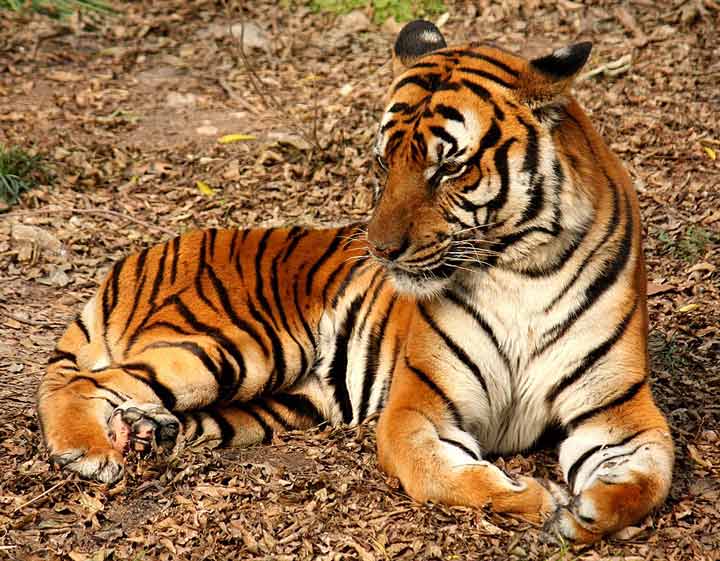The South China tiger is also known as the Amoy or Xiamen tiger. Once, It has a dominant presence in the dense forests of southern China, but today it is on the brink of extinction.
In this article, we will learn about the South China tiger’s history, characteristics, and the challenges it faces.
Quick Overview
| Common Name | South China tiger, Amoy Tiger, Xiamen tiger |
|---|---|
| Length | Males: 7.5-8.5 feet Females: 7 to 8 ft |
| Weight | Males: 130-175 kg Females: 100 – 115 kg |
| Lifespan | 15-20 years in captivity (wild lifespan unknown) |
| Diet | Carnivorous (wild boar, deer, smaller mammals) |
| Habitat | Forests of Fujian, Guangdong, Hunan, Jiangxi |
| Status | Critically Endangered (extinct in the wild) |
Taxonomy and Classification
In 1905, Max Hilzheimer identified the South China tiger as Felis tigris var. amoyensis based on unique skull features distinct from Bengal tigers.
This tiger is believed to represent an ancient “stem” tiger lineage, possibly originating from southern China or northern Indochina.
While a 2017 classification grouped all mainland Asian tigers under P. t. tigris, a 2018 study recognized the South Chinese tiger as a distinct subspecies among six.
| Kingdom | Animalia |
|---|---|
| Phylum | Chordata |
| Subphylum | Vertebrata |
| Class | Mammalia |
| Order | Carnivora |
| Suborder | Feliformia |
| Family | Felidae |
| Genus | Panthera |
| Species | Panthera tigris |
| Sub Species | Panthera tigris tigris |
Size
The South China tiger is a marvel of nature, characterized by its vibrant orange coat adorned with bold black stripes. This distinctive pattern helps to camouflage within its natural habitat.

The South China tiger is medium-sized. Males measure 7.5 to 8.5 ft (2.3 to 2.65 m) long and weigh around 130 to 175 kg (287 to 386 lb).
In contrast, females are slightly smaller. They span 7 to 8 ft (2.2 to 2.4 m) lengths and weigh approximately 100 to 115 kg (220 to 254 lb).
Historical Range and Habitat

Historically, the South China tiger was common in dense, lush forests spanning Fujian, Guangdong, Hunan, and Jiangxi provinces. With their rich biodiversity, these regions provided the tiger with ample prey and shelter.
The forests’ dense undergrowth and vast expanses allowed the tiger to roam freely, hunt efficiently, and establish dominance.
Diet
In the wild, the South China tiger primarily preyed on medium to large-sized ungulates like wild boar and deer, supplemented by smaller mammals such as rabbits and hares, and occasionally birds and fish.
In captivity, their diet is meticulously managed to ensure optimal health. They are typically fed raw meat, primarily beef or horse meat, complemented by whole prey items like rabbits or chickens.
These whole prey items are crucial as they provide essential nutrients found in bones and fur. Additionally, they receive specialized carnivore supplements to ensure a balanced intake of vitamins and minerals.
The Decline

In the 1950s, the South China tiger population was around 4,000. But a combination of factors led to its rapid decline.
A significant factor was the local government’s campaign that labeled these tigers as pests, leading to ruthless hunting. Additionally, rampant deforestation reduced the tiger’s prey, and human settlements fragmented their habitats.
By 1982, only 150-200 of these tigers were believed to be alive, and by the late 1980s, the number had further dwindled to a mere 30.
Current Status
It’s been over 30 years since a South China tiger was last spotted in the wild. This long absence has led many to believe the species might be extinct in the wild.
Today, the few remain in zoos and captivity. The South China tiger is now the most endangered of all tiger species.
Conservation Efforts
Despite the dire situation, there is still some hope. Organizations like “Save China’s Tigers” are working hard to reintroduce captive-born South China tigers into the wild.
The goal is to rewild these tigers, helping them relearn hunting instincts and eventually reintroduce them to their natural habitats in China.

Li Quan, a former fashion designer for Gucci, founded “Save China’s Tigers” to reintroduce the South China tiger to its natural habitat.
Under her leadership, the organization relocated tigers from Chinese zoos to a private reserve in South Africa called the Laohu Valley Reserve.
Here, the tigers are trained to become wild again, learning to hunt and reclaim their predatory instincts.
The project has seen successes, with the birth of tigers like “Hulooo”, the first South China tiger born outside China.
However, the path to reintroduction is fraught with challenges. There are debates about the feasibility of reintroducing a species absent from the wild for so long.
Some argue that efforts might be better directed towards subspecies that still have a fighting chance.
Why They Matter
The South China tiger’s plight is not just about the loss of a species. It’s a reflection of the broader environmental and ecological challenges we face.
The tiger’s decline is intertwined with habitat loss, human conflict, and broader ecosystem disruptions. Their survival is crucial for maintaining the delicate balance of their ecosystem.
Conclusion
The South China tiger’s story is a testament to the delicate balance of nature and the profound impact of human actions.
As we learn more about this incredible creature, it becomes evident that collective, informed action is our best hope for ensuring its survival.
FAQs
The South China tiger is one of the tiger subspecies native to southern China. It’s currently listed as critically endangered.
Historically, this tiger roamed the forests of provinces like Fujian, Guangdong, Hunan, and Jiangxi in China.
The population decline is attributed to factors like deforestation, habitat fragmentation, and large-scale government ‘anti-pest’ campaigns in the 1950s.
As of now, the South China tiger is believed to be extinct in the wild, with only a few individuals remaining in captivity.
This subspecies is known for its distinctive coat pattern, with narrower and more sharply defined stripes compared to other tiger subspecies.
Organizations like Save China’s Tigers are working to reintroduce captive-born South China tigers into the wild, aiming to rewild them and eventually reintroduce them into their natural habitat.
Apart from its unique coat pattern, the South China tiger is also smaller in size compared to other mainland Asian tiger subspecies.



